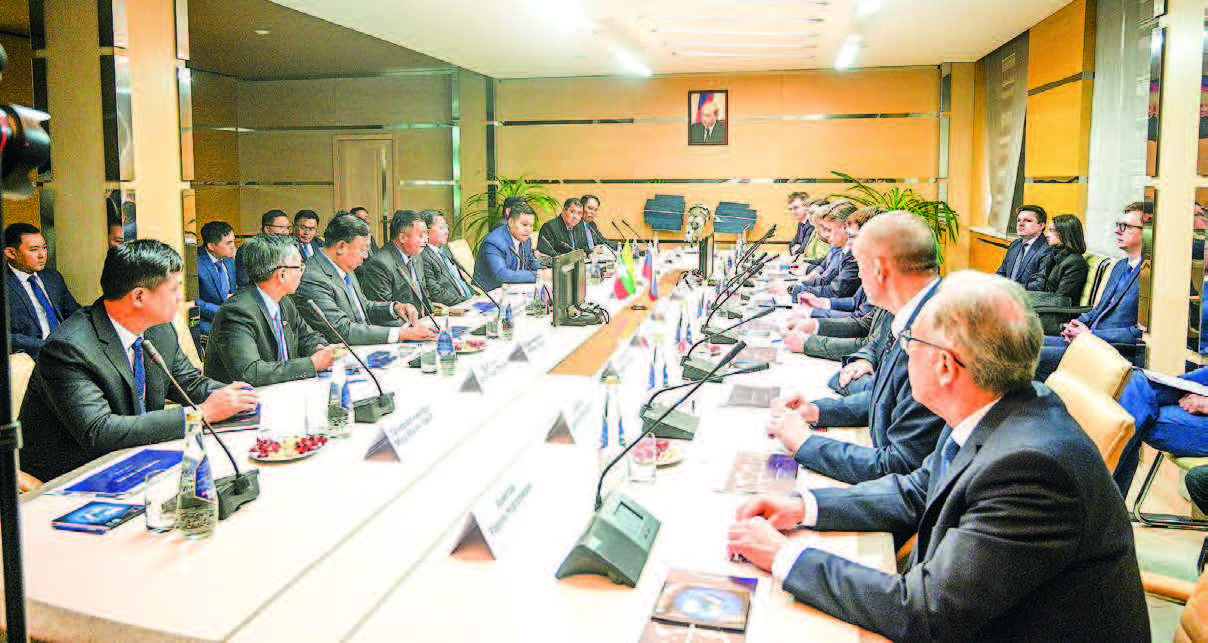By Yin Nwe Ko
IN a significant diplomatic and technological milestone, Senior General Min Aung Hlaing, Chairman of the State Administration Council and Commander-in-Chief of Defence Services , embarked on a high-profile visit to Russia. This visit, which took place on 2 September 2024, as noted in the official records, marks a pivotal moment in the strengthening of bilateral ties between the two nations. The primary focus of this collaboration is the peaceful advancement of space technology, a field that holds immense potential for Myanmar’s development. Here, let us explore the details of this partnership, the discussions held, the technological exchanges planned, and the profound benefits that Myanmar stands to gain from this alliance, all while emphasizing the commitment to peaceful applications of space exploration.
The Context of the Visit
The meeting between Senior General Min Aung Hlaing and high-ranking Russian officials, including the Senior General of the Russian Federation and the Deputy Prime Minister, underscored a mutual interest in fostering cooperation beyond traditional diplomatic channels. Held under the auspices of the State Administration Council Chairman Prime Minister Senior General’s Office, the discussions centred on leveraging Russia’s advanced space technology expertise to support Myanmar’s aspirations. The presence of key figures such as the Deputy Prime Minister and other senior officials from both nations highlighted the strategic importance of this partnership. The talks were not merely ceremonial; they were a concrete step toward integrating Myanmar into the global space technology ecosystem, with a clear emphasis on peaceful purposes.
The image accompanying the article depicts a formal meeting, with Senior General Min Aung Hlaing seated alongside Russian counterparts in a conference room, surrounded by an array of officials. This visual representation symbolizes the seriousness with which both nations are approaching this collaboration. Additionally, the second image showcases a rocket assembly process, hinting at the technological exchange that is at the heart of this partnership. These visuals serve as a testament to the tangible progress being made and the ambitious goals set forth during the discussions.
The Foundation of the Partnership
Russia has long been a global leader in space exploration, with a legacy that includes the launch of the first human into space, Yuri Gagarin, and the development of the Soyuz spacecraft. The country’s space agency, Roscosmos, has been instrumental in advancing satellite technology, rocket manufacturing, and interplanetary missions. For Myanmar, a nation with a burgeoning interest in modern technology but limited infrastructure in this domain, this partnership offers a unique opportunity to leapfrog into the 21st-century space age.
The discussions during Senior General Min Aung Hlaing’s visit focused on several key areas. First, there was an emphasis on the establishment of satellite technology, which could revolutionize communication, weather forecasting, and disaster management in Myanmar. Second, the collaboration extends to rocket manufacturing and space launch capabilities, with plans to potentially establish a joint factory or research facility. Third, the exchange of expertise between Russian and Myanmar scientists was a critical component, aimed at building local capacity over time. This multifaceted approach reflects a long-term vision for Myanmar’s integration into the global space community.
Peaceful Advancement of Space Technology
A cornerstone of this collaboration is the commitment to using space technology for peaceful purposes. The State Administration Council Chairman Prime Minister Senior General’s Office has explicitly outlined that the partnership with Russia will focus on “peaceful utilization of space technology”. This stance aligns with international norms and treaties, such as the Outer Space Treaty of 1967, which mandates that space exploration be conducted for the benefit of all countries and prohibits the placement of weapons of mass destruction in orbit.
For Myanmar, the peaceful application of space technology translates into tangible benefits across multiple sectors. Satellite technology, for instance, can enhance communication networks in remote regions, where traditional infrastructure is lacking. Weather satellites can provide early warnings for natural disasters such as cyclones and floods, which are frequent challenges in Myanmar due to its geographical location. Moreover, space-based data can support agricultural planning, enabling farmers to optimize planting and harvesting schedules based on precise meteorological information.
The rocket assembly process depicted in the image is a symbol of this peaceful intent. Rather than being geared toward military applications, the technology transfer is intended to support scientific research, education, and industrial development. This aligns with the broader goal of fostering regional economic integration, as Myanmar seeks to position itself as a key player in Southeast Asia’s technological landscape.
Benefits for Myanmar
The potential benefits of this collaboration for Myanmar are vast and multifaceted, touching upon economic, educational, and social dimensions.
Economic Growth and Industrial Development
One of the most immediate advantages is the boost to Myanmar’s industrial sector. The establishment of a joint rocket factory or space technology facility, as hinted at in the discussions, could create thousands of jobs. This would not only reduce unemployment but also stimulate related industries such as metallurgy, electronics, and engineering. The production of fertilizers, a critical need for Myanmar’s agrarian economy, could also be enhanced through space-derived technologies, such as precision agriculture guided by satellite imagery.
Furthermore, the export of space technology components or services could open new revenue streams for Myanmar. By partnering with Russia, a nation with a robust space industry, Myanmar could eventually contribute to the global supply chain, elevating its economic status on the international stage.
Educational Advancement
Education is another area poised for transformation. The exchange of scientists and engineers between Russia and Myanmar will facilitate knowledge transfer, enabling the training of a new generation of space professionals. Universities in Myanmar could introduce space science curricula, fostering innovation and research. This educational upliftment is crucial for a country that has historically faced challenges in building a skilled workforce in high-tech fields. The image of the rocket assembly also serves as an inspirational tool. It can motivate young Myanmar students to pursue careers in science, technology, engineering, and mathematics (STEM), thereby laying the foundation for a knowledge-based economy.
Regional and Global Integration
On a broader scale, this partnership enhances Myanmar’s role in regional and international affairs. By collaborating with Russia, Myanmar gains access to a network of space-faring nations, potentially including China and India, which are also active in the region’s space race. This integration could lead to joint missions, shared satellite networks, and cooperative disaster response systems, strengthening Myanmar’s position in Southeast Asia.
The visit’s emphasis on regional economic integration, as noted in the document, suggests that Myanmar aims to use space technology as a tool for diplomacy and development. For instance, satellite data could be shared with neighbouring countries to address transboundary issues such as climate change and resource management.
Challenges and Considerations
While the prospects are promising, this collaboration is not without challenges. Myanmar’s current technological infrastructure is limited, and significant investment will be required to build the necessary facilities and train personnel. Additionally, the political context of Myanmar, including international sanctions and internal conflicts, could complicate the implementation of such ambitious projects. However, the focus on peaceful applications may help mitigate some of these concerns, as it aligns with global efforts to promote sustainable development.
Another consideration is the need for transparency and accountability. As Myanmar embarks on this journey, it must ensure that the benefits of space technology are equitably distributed across its population, particularly in rural and underserved areas. The government will need to work closely with international partners and civil society to achieve this goal.
The Road Ahead
The visit by Senior General Min Aung Hlaing to Russia is just the beginning of what promises to be a transformative partnership. The establishment of the State Space Corporation “Roscosmos” office in Myanmar, as mentioned in the document, is a concrete step toward operationalizing this collaboration. Plans include the assembly of satellites and the development of a launch site, potentially near the Tanintharyi Region, which offers strategic geographical advantages.
The peaceful advancement of space technology also opens the door to cultural exchanges. Joint missions could involve Myanmar astronauts training in Russia, fostering a sense of pride and unity among the populace. Additionally, the collaboration could inspire artistic and educational initiatives, such as planetariums or space museums, to engage the public.
The partnership between Myanmar and Russia in the peaceful advancement of space technology represents a bold vision for the future. Under the leadership of Senior General Min Aung Hlaing, Myanmar is poised to harness Russia’s expertise to address its developmental challenges while contributing to global scientific progress. From enhancing communication and disaster preparedness to boosting economic growth and education, the benefits are far-reaching. As this collaboration unfolds, it will be essential to maintain a focus on peace, equity, and sustainability, ensuring that the skies above Myanmar become a symbol of hope and progress for generations to come.
This alliance is not just about rockets and satellites; it is about building a bridge between nations, fostering innovation, and uplifting society. With a commitment to peaceful utilization and a strategic roadmap, Myanmar and Russia are setting the stage for a new era of technological collaboration that could redefine the region’s future.
Chairman of the State Administration Council Prime Minister Senior General Min Aung Hlaing and Director- General Mr Dmitry Bakanov of the State Space Corporation “Roscosmos” discuss on cooperation in the peaceful utilization of space technology.


